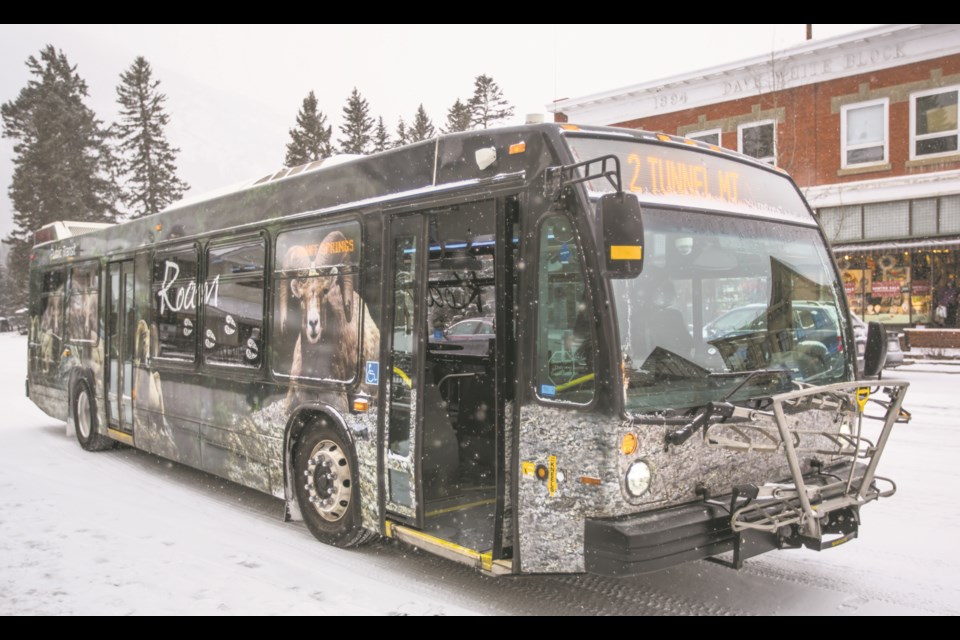BANFF – A bid by Banff’s mayor to steer paid parking revenues into climate-driven initiatives met the end of the road.
At a Monday (Nov. 13) council meeting, Mayor Corrie DiManno’s proposal to allocate some parking profits toward municipal climate resiliency and green energy initiatives was opposed by Banff council 3-2, primarily over concerns of saving funds for future public transit needs.
“It’s difficult for me to dilute some of these visitor paid parking reserves without knowing the full grasp of what is going to be required for transit moving forward. It’s not that I’m opposed to doing something as it relates to environment initiatives – not at all,” said Coun. Grant Canning, who voted against the move. “It’s just for me it’s always been about diluting that fund into other things until we know. Just reading the tea leaves, it’s going to be a very big ask moving forward with transit and our rolling stock and everything else.”
In 2016, Roam transit had a $1.958 million budget, supporting 19,891 service hours. The budget for 2024 is roughly $11.93 million and about 75,000 service hours – a significant increase to meet growing transit demands in the Bow Valley as services has been added in Lake Louise, Canmore, Banff and sites in Banff National Park. The transit budget has been endorsed by the Bow Valley Regional Transit Services Commission (BVRTSC), but could still see changes when its municipal members approve their budgets.
For Banff, two new electric buses are planned to be added to its fleet in 2025 and the purchase of two more is also supported in 2026 with record-breaking level ridership on Banff routes 1, 2 and 4 reported in August. For Banff routes, local residents of the mountain community can ride for free.
In its budget, BVRTSC endorsed additional early morning service to Banff’s industrial compound, extended summer season, increased winter service and a hybrid electric bus purchase for Banff local service in 2026, but the increase in services would be fully funded by the Town of Banff.
Canning noted until council has a clearer picture of the transit commission’s total ask of the Town, he didn’t feel comfortable reallocating funds that could be needed later. He emphasized the importance of continued investment into transit, which is a permitted spend of operating and capital funds for paid visitor parking.
“As it relates to environmental initiatives and things we can do to make a real substantial progress on environmental initiatives, I don’t think there is anything else out there that’s better for us than transit,” he said. “I think that is by far the most important thing; the biggest bang for the buck.”
Coun. Hugh Pettigrew echoed Canning’s comments and added the Town should preserve parking revenue “for a rainy day.”
Projected balances for the visitor paid parking operating reserve is $577,385 in 2023, $1.7 million in 2024, and $1.85 million in 2025. For the capital paid parking reserve, the anticipated ending balances are $1.5 million in 2023, $1.56 million in 2024, and $814,300 in 2025. Key capital expenditures include constructing the Mountain Avenue dedicated express lane in 2024 and acquiring an electric bus in 2025.
Acknowledging the importance of public transit, DiManno argued Roam transit has various other funding sources, including Banff’s transit reserve and BVRTSC’s transit reserve for capital projects in Banff, where needed.
“There’s multiple ways to fund transit whereas there’s not a lot of different ways to be able to fund climate adaptation,” she said.
The Town’s environmental reserve is also in a “rebuilding phase,” she said, and would likely not be a reliable source to fund climate resiliency projects in the near future.
“The reason I wanted to add this is because I feel like it correlates more strongly to reducing GHG (greenhouse gas) emissions and just trying to help us prepare for, respond to, recover from impacts of any kind of climate events,” said DiManno.
“I see this as a way to support our climate action plan as well as our strategic plan without having to increase tax support.”
The Town of Banff’s climate goals include an 80 per cent reduction in GHG emissions and a transition to 100 per cent renewable energy by 2050.
Implementing the plan carries a significant cost, with financial modelling projecting a $327 million community investment over 30 years. However, it also anticipates a net cost savings of over $453 million during the same period.
The mayor’s bid to give council the option to redirect parking revenue for these projects was solely supported by Coun. Barb Pelham. Discussion of the bid was postponed from the Oct. 23 council meeting to allow a full council table, with Couns. Chip Olver and Ted Christensen absent.
The Local Journalism Initiative is funded by the Government of Canada. The position covers Îyârhe (Stoney) Nakoda First Nation and Kananaskis Country.




